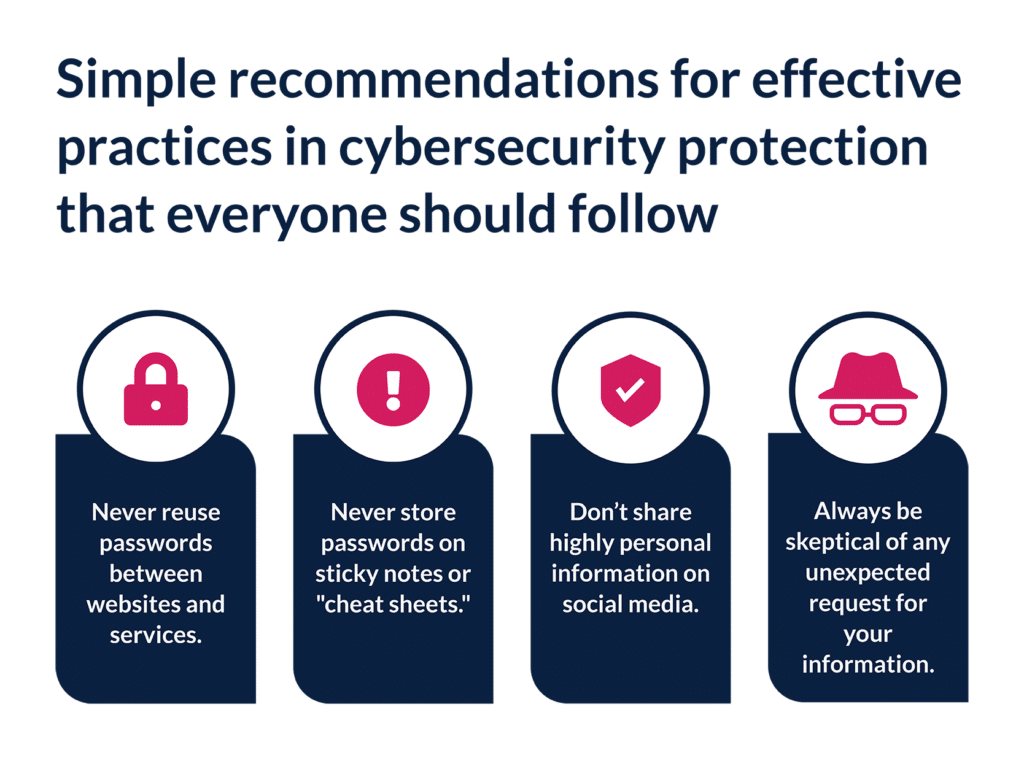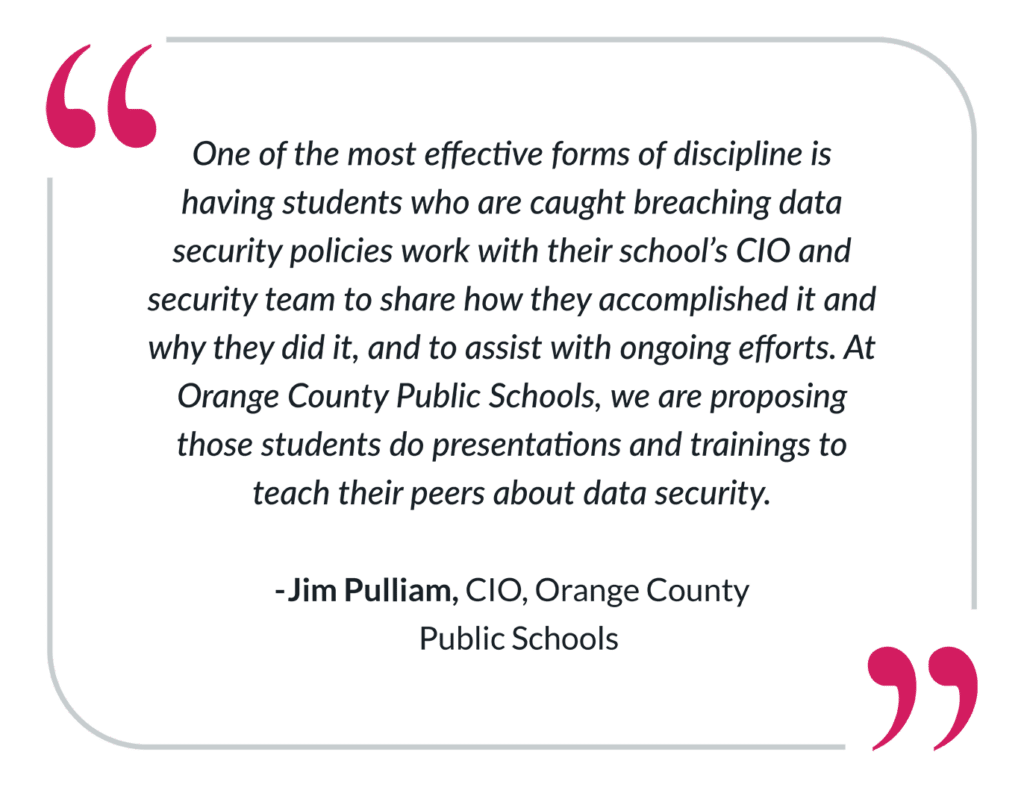K-12 school cybersecurity tips
This is a scary time in cybersecurity for K-12 schools. By 2021, a majority of American schools had experienced a security breach, and now, in 2022, the education industry is the no. 1 target for cyberattacks. Simply put, cybercriminals view schools as easy targets that hold a wealth of personal data from staff and students.
To keep your students safe, your district must take all available steps to protect your network. Further, you must educate your whole community—students included—on the importance of cybersecurity and the role each person plays in keeping everyone safe.
Below are actionable K-12 school cybersecurity tips and solutions every district can deploy to help prevent cyberattacks and increase cybersecurity in your schools today.

1. Create clear cybersecurity guidelines for staff
Have you put together guidelines on safe password usage? What about staff policies for downloading apps or plug-ins?
Put together a list of K-12 school cybersecurity tips that everyone should follow, such as these:
- Never reuse passwords between websites and services. Instead, use unique passphrases on each site.
- Never store passwords on sticky notes or “cheat sheets” where students can find them.
- Don’t share highly personal information on social media. Doing so jeopardizes your safety.
- Always be skeptical of any unexpected request for your information.
Next, be sure students and teachers know your cybersecurity guidelines and how your filtering policies help achieve community safety. Also, make your acceptable use policy (AUP) concerning devices and online best practices transparent and visible. Doing so helps mitigate cybersecurity risks by ensuring your community uses its devices responsibly.
Further, stress to all members of your community, repeatedly and clearly, what to do when they confront something they think may be a cybersecurity risk: ask for help. Often, when people are unsure if something poses a risk, they stay silent in order not to bother anyone. Your community will be safer if people feel comfortable reaching out.
2. Get parents and teachers involved
It’s key that you teach K-12 school cybersecurity tips to teachers and parents so they can help cultivate safe practices in your students. Educated and empowered teachers pass along their cybersecurity knowledge to students and making parents aware of your security practices is a great way to get them to talk to students at home about how to be safe online.
Your district’s software can help get parents involved and keep them informed. For instance, with Lightspeed Filter™, parents can receive automated weekly student activity reports through Parent Portal. The insights in these reports can help spark constructive conversations about cybersecurity and appropriate device use.
3. Block malicious sites and content
Viruses can lurk in email attachments, websites, ads, social media, proxy sites, and holes in unpatched software. Again, this is where your school’s content filter comes into play.
It takes URL categorization with powerful AI to identify the millions of new sites created each day—and to protect your students from the emerging threats. Software like Lightspeed Filter automatically blocks new/unknown sites while categorization is occurring. So, if there’s a new malware site that pops up overnight, districts don’t have to worry about students finding it in the morning. Also, Lightspeed Filter’s categorization engine processes more than two million new sites each day, ensuring security threats are blocked and categorized as soon as possible.
Lightspeed Filter organizes sites that pose security risks into seven categories:
- Security: Sites providing information that poses security risks
- Malware: Viruses, spyware, phishing
- Net Tools: Filter bypass methods, tutorials, etc.
- Proxy: Anonymous proxies, tutorials
- Shorteners: URL shortening services
- Translators: Language translation sites
- Warez: Distribution of pirated software
When a student attempts to visit sites that pose a security risk, Lightspeed Filter produces a block screen explaining why access was denied and how the student can contact IT support if further discussion is needed. Additionally, schools can use Lightspeed Filter to lock the student out for a period of time the school administrator has determined. Doing so both protects your network and educates students about cybersecurity.

4. Educate students on appropriate device use
Jim Pulliam, CIO at Orange County Public Schools and a Lightspeed Systems® customer, devised a clever strategy for dealing with students who violate school security policies—and for making the most of his tech-savvy students. “One of the most effective forms of discipline is having students who are caught breaching data security policies work with the school’s CIO and security team to share how they accomplished the violation and why they did it, and then to assist with ongoing efforts to protect [the school from cyberattacks],” he said. “At Orange County Public Schools, we are proposing that those students do presentations and trainings to teach their peers about data security.”
Enlisting students as “white hat hackers” allows them to be part of the cybersecurity solution. When district leaders learn from the ingenuity students show in evading the rules, they can make their networks more secure than they would be able to do on their own.
5. Deploy the best solutions to protect your school-issued devices
Too many schools settle for filters that fail to block some of the most malicious content online. With Lightspeed Filter, you get the most robust web categorization and tools to protect your network. Compromising sites and filter bypass tools are easily identified and blocked by our solution to ensure student online safety. Because Lightspeed Filter works on both BYOD and school-owned devices, it keeps your community safe while making your network dynamic and flexible.
At Lightspeed Systems, we understand security. Our commitment to student and district data protection is unrivaled. Lightspeed Systems is one of the only providers on the market that boasts a dedicated team of expert data scientists and database operators to ensure optimal student safety and data security from the roots up—and every Lightspeed employee, no matter the department, receives ongoing security training. Additionally, Lightspeed Systems holds education competency status with Amazon Web Services (AWS), ensuring the most secure environment for our products and our customers.
“We believe security is everyone’s responsibility, so we train and empower our people to look for and identify risks,” said John Genter, Vice President of Security and Cloud Operations at Lightspeed Systems. “Taking care of the little things is what helps Lightspeed Systems build products our customers trust because they know we keep their data safe.”
Lightspeed Filter works to keep students productive while filtering out dangerous content. See for yourself and learn how Lightspeed Filter can protect your students from harmful online content.

